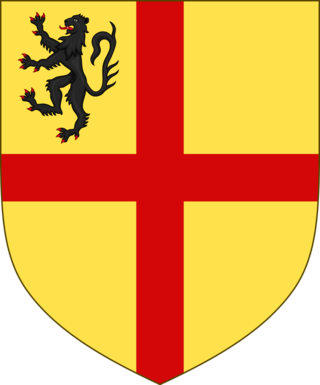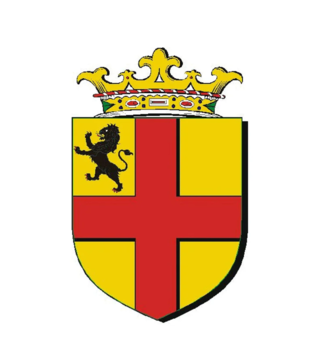
Earl of the County of Mayo, usually known simply as Earl of Mayo, is a title in the Peerage of Ireland created, in 1785, for John Bourke, 1st Viscount Mayo. For many years he served as "First Commissioner of Revenue" in Ireland. He had already been created Baron Naas, of Naas in the county of Kildare, in 1776, and Viscount Mayo, of Moneycrower in the county of Mayo, in 1781, also in the Peerage of Ireland.

Earl of Clanricarde is a title that has been created twice in the Peerage of Ireland, first in 1543 and again in 1800. The former creation became extinct in 1916 while the 1800 creation is extant and held by the Marquess of Sligo since 1916.

The House of Burgh or Burke was an ancient Anglo-Norman and later Hiberno-Norman aristocratic dynasty which held the earldoms of Kent, Ulster, Clanricarde, and Mayo at various times, provided queens consort of Scotland and Thomond and kings of Britain, and played a prominent role in the Norman invasion of Ireland.

William de Burgh was the founder of the House of Burgh in Ireland and elder brother of Hubert de Burgh, 1st Earl of Kent and Geoffrey de Burgh, Bishop of Ely. William is often given the epithet, "the conqueror", but is not to be confused with the English king of the same nickname.

Sir William Óg de Burgh was an Anglo-Irish noble and soldier who was the ancestor of the Earls of Clanricarde and the Mac William Iochtar.
The Burke/de Burgh Civil War was a conflict in Ireland from 1333 to 1338 between three leading members of the de Burgh (Burke/Bourke) Anglo-Norman family resulting in the division into three clans.

Sir Uilleag (Ulick) de Burgh (Burke), 1st Clanricarde or Mac William Uachtar was an Irish chieftain and noble who was leader of one of the three factions who fought the Burke Civil War in the 1330s. By the end of the conflict he had established himself and his descendants as Clanricarde, also known as Mac William Uachtar, independent lords of Galway. He was succeeded by his son, Richard Óg Burke, 2nd Clanricarde (d.1387).

Clanricarde, also known as Mac William Uachtar or the Galway Burkes, were a fully Gaelicised branch of the Hiberno-Norman House of Burgh who were important landowners in Ireland from the 13th to the 20th centuries.

Viscount Mayo is a title that has been created twice in the Peerage of Ireland, both times for members of the Bourke family. The first creation came in 1627 in favour of Tiobóid na Long Bourke, also known as Theobald Bourke. He was the son of Sir Richard Bourke, 18th lord of Mac William Iochtar, and Gráinne O'Malley. Miles, the 2nd Viscount, was created a baronet in the Baronetage of Nova Scotia in c. 1638.

William Burke, 7th Earl of Clanricarde, PC (Ire), was an Irish peer who fought in his youth together with his brother Richard, 6th Earl of Clanricarde under their cousin, Ulick Burke, 1st Marquess of Clanricarde against the Parliamentarians in the Cromwellian conquest of Ireland. He succeeded his brother as the 7th Earl in 1666.

Shrule Castle is a ruined tower house near Shrule in County Mayo, Ireland. The castle was built c.1238, near the Black River at the County Mayo and County Galway border by the de Burgh family. It was given to John de Burgh in 1308 by his father Richard Óg de Burgh, 2nd Earl of Ulster.
Sir Edward Fitton the Elder, was Lord President of Connaught and Thomond and Vice-Treasurer of Ireland.

Tibbot na Long Bourke, 1st Viscount Mayo was an Irish peer and parliamentarian. A prominent member of the MacWilliam Burkes of County Mayo, Tibbot was a Member of the Irish House of Commons and was later created the first Viscount Mayo. His successful life followed, and usefully illustrates, the difficult transition for Irish aristocrats from the traditional Gaelic world during the Tudor conquest of Ireland.
Edmond Albanach de Burgh, 1st Mac William Íochtar was an Irish chieftain and noble who established himself as the most powerful lord in Connacht west of the Shannon.
Sir William Liath de Burgh was an Irish noble and Justiciar of Ireland (1308–09). He was an ancestor of the Mac William Uachtar and Mac William Íochtar who were earls of Galway and Mayo respectively.

Mac William Íochtar, also known as the Mayo Burkes, were a fully Gaelicised branch of the Hiberno-Norman House of Burgh in Ireland. Mayo covered much of the northern part of the province of Connacht and the Mac William Íochtar functioned as a regional king and received the White Rod. The title was a successor office to the Lord of Connacht which ended upon the assassination of William Donn de Burgh, 3rd Earl of Ulster, in June 1333.
Richard Óg de Burgh was an Anglo-Irish noble and soldier who was the ancestor of de Burgh/Burkes of Clanricarde.
Tibbot MacWalter Kittagh Bourke, 21st Mac William Íochtar was the first and last person to hold that title following its restoration. He was inaugurated at Kilmaine by Hugh Roe O'Donnell in December 1595 to secure Mayo for the rebel Irish Alliance during the Nine Years' War. His rule was opposed by many Bourke nobles, most notably by his arch-rival, the loyalist chief Tibbot na Long Bourke. The two men fought for supremacy over the MacWilliam Lordship throughout the war and control of the area changed hands on numerous occasions. Following Kittagh's flight to Spain in 1602, the MacWilliam chieftainship was abolished yet again, and Tibbot na Long would thereafter be made Viscount Mayo.

The de Burgo Baronetcy, of Castle Connell in the County of Limerick, was a title in the Baronetage of Ireland created on 16 June 1785 for Richard de Burgo. The first Baronet was born Richard Burke, but later assumed the surname of de Burgo. The title became extinct on the death of the fourth Baronet in 1873. The de Burgo family were believed to be a branch of the Burke family headed by the Earl of Clanricarde.
Helen Burke, Countess Clanricarde, also styled Helen FitzGerald, was brought to France by her mother fleeing the Cromwellian conquest of Ireland, against which her father, the 2nd Earl Muskerry, resisted to the bitter end. In France, she was educated at the abbey of Port-Royal-des-Champs together with her cousin Elizabeth Hamilton. She married three times. All her children were by her second husband, William Burke, 7th Earl of Clanricarde. She was the mother of Ulick Burke, 1st Viscount Galway, Margaret, Viscountess Iveagh, and Honora Sarsfield.












